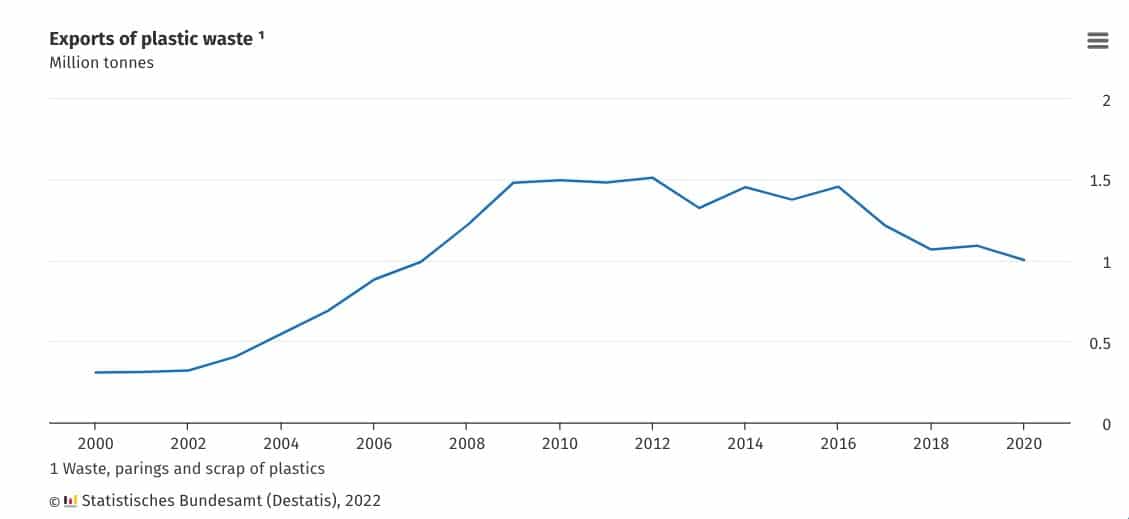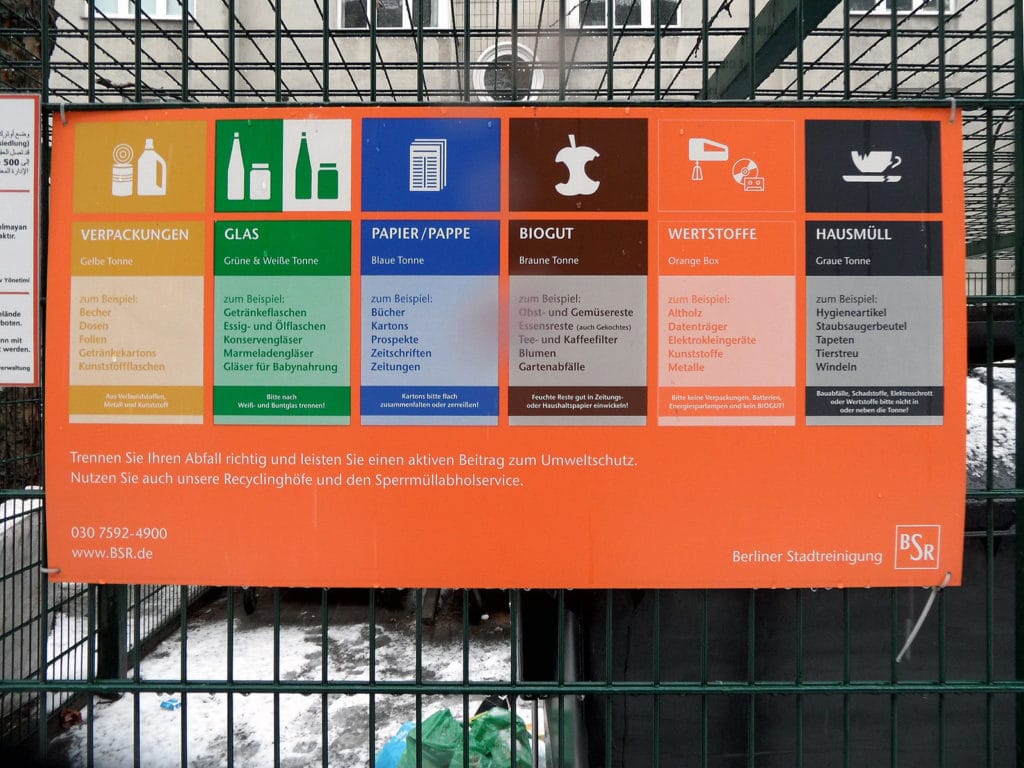Germany has been celebrated as a world leader in recycling. Its waste management system and sorting policies have paved the way for other countries to implement greener practices when it comes to trash disposal and collection. We take a look at the country’s main strategies and the impact they have had on the rest of the world.
—
Municipal waste covers a vast range of different categories of trash, from domestic and organic waste to paper, glass, packaging, and electrical appliances just to name a few. Managing such a broad and heterogenous variety of waste has always been particularly challenging for cities across the world. However, in recent years, several local and national governments have designed systems and adopted approaches to facilitate the collection, sorting, and recycling of waste. Germany is considered a leader in recycling and waste management and its success story comes down to two factors: strong government policies and high public awareness in recycling. We explore the main strategies in more detail and discuss how these can inspire countries around the world to develop more efficient systems to deal with their waste.
Germany: The Leading Recycler of Municipal Waste
Over the last two decades, Germany has adopted a series of strategies – such as mandatory waste sorting policies and an extremely efficient deposit refund scheme – that have significantly improved its waste management and increased its recycling rates. The country also introduced a so-called ‘Energiewende’, a roadmap to the low-carbon and renewable energy transition and in shaping the public opinion on the importance of environmentally sound management of waste.
In Germany, recycling rates have been relatively high for decades. Already in 2002, the country was recycling 56% of its trash and a clear rise has been observed since then. It is also currently the leading recycler of municipal waste in the European Union (EU), in which the 27-nation bloc similarly passed a number of directives to set specific recycling standards. In 2008, for example, the EU approved the Waste Framework Directive, which set basic concepts related to waste management, including definitions of prevention, re-use, recycling, recovery, and disposal. Moreover, it imposed a target for all member countries to reach a minimum recycling rate of 50% for certain materials by 2020. The German Federal Government increased this requirement through the Circular Economy Act of 2012, setting a 65% recycling rate. In 2018, the amended Waste Framework Directive laid down the following targets for municipal waste across European nations: 55% by 2025, 60% by 2030, and 65% by 2035. Germany surpassed the latter a long time ago and in 2019, its estimated recycling rate reached roughly 67%.
The Deposit Refund Scheme
To date, several North American and South Australian states, as well as 10 European nations, have implemented a Deposit Refund System (DRS). Under the scheme, bottles that can be recycled are labelled accordingly. When purchasing them, consumers pay a deposit – which in Germany ranges between €0.08 and €0.25. This amount is reimbursed once the empty bottle is returned to a retail store. “One-way” plastic bottles are in the higher price range, while the deposit for reusable glass and plastic bottles usually do not exceed €0.15. The difference in price is a strategic way to encourage consumers to return these environmentally-damaging plastics. Indeed, having paid a higher deposit for non-reusable bottles, consumers are particularly incentivised to bring them back once after use. Furthermore, making plastic bottles pricier is another way to make them less attractive products to buy altogether.
A DRS has proven to be extremely effective in countries like Germany, which has reached a staggering 98.4% return rate since the adoption of the scheme, making it undoubtedly a successful waste management solution with an overwhelmingly positive impact on waste production. It is not only efficient in reducing littering generation, but it can also increase bottle recycling and help industries and consumers to develop a more responsible and sustainable mindset, in line with the polluter-pays principle such scheme is based on. The principle is based on the belief that those who produce pollution should bear the costs of managing it to prevent it from damaging human health as well as the environment. The Federal Government recently revised the scheme to combat the ever-growing waste production across the country and announced that starting from 2024, all containers for milk and dairy products will also be subject to a deposit.
You might also like: Waste Management solutions From Around the World
Mandatory Waste Sorting Policies
Germany passed three major policies that have changed the waste management system for the better. They are based – like the DRS – on the ‘polluter pays’ principle. In this case, manufacturers and private industries are also responsible for eliminating waste and covering the costs.
1. The Packaging Ordinance (1991)
Through the Packaging Ordinance, Germany was the first country to introduce binding requirements to manufacturers for the recycling and recovery of sales packaging. This includes transportation packaging, primary packaging like cans as well as secondary packaging like the carton box cans are sold in. In 2019, the Ordinance was replaced by the Packaging Act, which contains new, more ambitious recycling rates and targets (see Figure 1) and further important regulations for a more transparent and economic competition. Mandatory recycling fees for packaging producers and distributors remain in place. However, in order to operate, German companies now also have to be listed in the Central Agency Packaging Register, to which they regularly report their products’ masses and materials.

2. The Green Dot System (1991)
Another milestone was reached after the German government adopted the Green Dot System, forcing manufacturers to place a green label outside of packaging indicating it must be accepted by recycling facilities. In order to make use of the labelling system, producers pay a fee to the Dual System Germany, a public-private partnership for waste collection set up around the same time which allows private companies to pick up household packaging in parallel to the already existing municipal waste collection systems. The strategy is considered the frontrunner of the European Green Dot Scheme, which has since been adopted by more than 130,000 companies across 23 European countries with overwhelmingly positive results. Today, over 460 billion packages are labelled with the Green Dot.
3. Closed Substance Cycle and Waste Management Act (1996)
The last of such policies adopted by Germany was the Closed Substance Cycle and Waste Management Act in 1996. The Act comprehensively extended the policies enclosed in the Packaging Ordinance, requiring whoever produces, markets, and consumes goods to be responsible for the avoidance, reuse, recycling, and environmentally compatible disposal of waste that arises. It encouraged businesses to radically rethink their production system – making sure that most products are produced with recyclable materials – as well as promote low-waste products and displace waste in an environmentally-sound way. The Act was amended in 2012, when Germany adopted the Circular Economy Act, which set legally binding measures on the part of manufacturers and distributors to promote producer responsibility. Little by little, regulations were established for vehicles, electrical and electronic devices, batteries, and oil.
The aforementioned policies have had overwhelmingly positive results, and saw recycling rates increased while building an understanding and acceptance of the recycling culture among the public. It also incentivised local governments to adopt stricter regulations and companies to have solid recycling standards in place. To facilitate this, one of the first adopted measures was to increase the amount of recycling bins around cities, which allow separating trash into six different categories: generic waste, paper, plastic, clear glass, coloured glass, and composting. The pre-sorting system enables the Federal Government to save money on waste disposal and management and it drastically reduces the contamination of recycled materials, which would otherwise compromise entire batches of waste and prevent them from being recycled.
You might also like: What Are the Consequences of China’s Import Ban on Global Plastic Waste?
Ban on Single-Use Plastics and Plastic Bags
At the end of 2019, the German Federal Government introduced a ban on plastic bags through an amendment to Article 5 of the Packaging Act, and in the context of the EU’s Circular Economy Action Plan, the country also implemented stricter rules on single-use plastics, prohibiting manufacturers to produce as well as import these types of plastics.
The ban came at the right time. While the country is great at reusing and recycling its plastics, it still remains one of Europe’s biggest plastic producers and the EU’s largest exporter of plastic waste. On average, Germany exports around one million tons of plastic every year, worth around €254 million (approximately USD$275 million). Before China imposed an import ban on waste in 2018, the country was one of its biggest customers. Since then, Germany has diverted waste to Malaysia as well as the neighbouring Netherlands, where 15% of German plastic waste ends up. On a better note, exports have shown signs of declining, dropping by 8% between 2019 and 2020 and 33% in the last 10 years.

Germany’s Waste Flaws
Germany is a great example of running an effective and efficient waste management system. However, this is just part of the story. Despite being a leader in recycling and having a solid waste management system, the country is also one of Europe’s biggest producers of packaging waste, especially plastics. Between 2005 and 2016, the average amount of waste produced in other EU-states declined whereas in Germany, it grew by almost one-tenth.
A recent statistic by the Federal Statistical Office found that in 2020 – the first year of the COVID-19 pandemic – nearly 6.5 million tonnes of packaging waste were collected and per capita packaging waste was up by 6 kilograms from the previous year. For decades Germany had to rely on third countries like China to manage its waste. With China’s import ban, it highlighted a hidden side to Germany’s waste situation; as important it is to have a strong recycling system in place, it is more so to avoid plastic waste piling up in the first place. And this is where the country still has much work to do.
Lastly, it is important to note that waste incineration remains one of the main pillars of waste management in Germany. Waste burning can be used to generate electricity and heating. In the country, this share is equivalent to approximately 1.5% of the total annual primary energy consumption. While this is good news, some environmentalists question whether incinerators are the best way to treat waste, with studies pointing out that these emit more toxins and pollutants than landfills, thus adding a significant negative contribution to air quality.
You might also like: 3 Lessons from Waste Management Around the World
No System is Perfect
It’s clear that Germany’s waste management approach is both widely successful as well as flawed, and that we are not looking at a perfect system. And yet, the country’s efforts to step up recycling and reduce waste pollution over the last few decades have been praised worldwide and numbers show that Germany is on the right path. While some of its policies – such as the single-use plastic ban and the Green Dot System – have now been adopted by other European countries but also by governments around the world, there are other strategies – like the Deposit Refund Scheme – that are not as widespread despite their extremely high effectiveness and promising results. Thus, looking at how Germany is fighting its own waste battle can serve as a lesson to nations who are still struggling to find their own ways of efficiently managing the trash they produce.
Featured Image by: Flickr
This story is funded by readers like you
Our non-profit newsroom provides climate coverage free of charge and advertising. Your one-off or monthly donations play a crucial role in supporting our operations, expanding our reach, and maintaining our editorial independence.
About EO | Mission Statement | Impact & Reach | Write for us


















